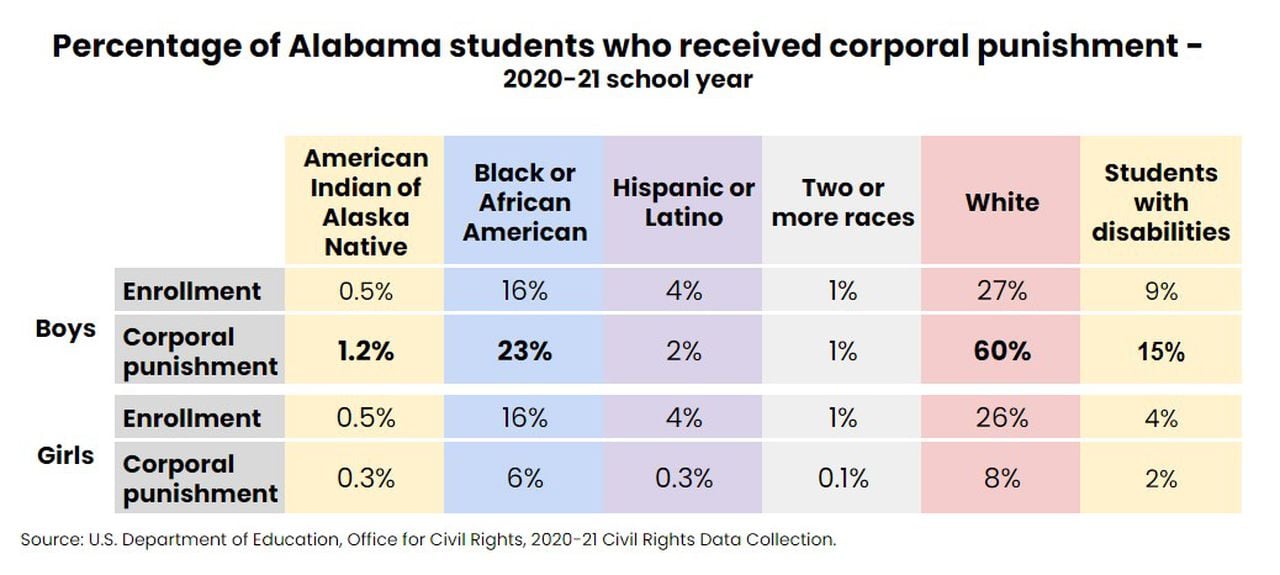Alabama kept paddling students during the pandemic. See your schoolâs data.
Alabama schools continued paddling students during the 2020-21 school year, though in much fewer numbers than previous years, according to new data from the U.S. Department of Education.
In that year, the most recent year for which data is available, 2,312 Alabama public school students were paddled 2,649 times, meaning some students were paddled more than once. That’s down from the 2017-18 school year, when 9,116 students were paddled 10,870 times.
The drop in total number, according to senior education department officials, is likely in part due to remote learning that year. Many schools that reported zero incidents still have policies on the books that allow corporal punishment.
Alabama allows local boards of education to decide whether to allow the use of corporal punishment, which typically involves hitting part of a student’s body with a paddle.
In a call with reporters Wednesday, senior education department officials cautioned against comparing the 2020-21 school year data with previous years’ data.
Which schools still paddle students in Alabama?
Nearly all of the schools that paddled students during the 2020-21 school year are located in rural areas of the state. Greenville Middle School in Butler County paddled students the most, clocking 125 incidents among 126 students, according to the data.
Some schools that reported hundreds of paddling incidents in 2017-18 reported zero during the 2020-21 school year. Many schools that reported zero incidents, including schools in Lawrence County, Choctaw County and Selma City, have policies that still allow corporal punishment.
A full list of schools that reported one or more paddling incidents during the 2020-21 school year is at the end of this article.
Who gets paddled the most?
As for who gets paddled the most in Alabama, that hasn’t changed. Boys of all races are more likely to be paddled than girls. The rates of paddling dropped significantly from the 2017-18 school year, but as education officials cautioned, AL.com is avoiding direct comparisons of the data.
Among boys, American Indian and Native Alaskan boys are paddled at the highest rates relative to their percentage of the student population, followed by white boys and Black boys.
Among girls, American Indian and Native Alaskan girls are paddled at the highest rates, followed by Black girls and white girls.
Students with disabilities also were overrepresented. Students with disabilities comprised 13% of all public school students in 2020-21 but accounted for 17% of all students who were paddled.
The chart below shows the number of students in each group that were paddled during the 2020-21 school year along with enrollment.
The percentage of Alabama students in public schools who received corporal punishment during the 2020-21 school year. Trisha Powell Crain / AL.comTrisha Powell Crain / AL.com
How Alabama compares to other states
The majority of U.S. states prohibit the use of corporal punishment, but it is still allowed in all Southeast and many Midwest states.
Among the 16 states that reported using corporal punishment during the 2020-21 school year, Alabama paddled the third-highest number of students behind Texas and Arkansas. That’s up from fourth-highest among states in the 2017-18 school year.
The map below shows the number of instances of corporal punishment during the 2020-21 school year. Click here if you are unable to see the map.
During the call Wednesday, U.S. Education Secretary Miguel Cardona said his department has “called for an end to corporal punishment. In March he issued a “Dear Colleague” letter urging state leaders “to move swiftly toward condemning and eliminating it.”
In the March letter, which noted academic research backing up the claim that corporal punishment causes harm to students, Cardona wrote:
“[Corporal punishment] is also associated with higher rates of mental health issues, including mood, anxiety, and other personality disorders, drug and alcohol use disorders, higher rates of aggression, antisocial behavior, and other externalizing problems, and lower cognitive ability relating to verbal capacity, brain development, and academic achievement.”
A movement to end paddling in Alabama schools gained steam in 2016, when the Obama administration urged schools to stop using it. Alabama’s superintendent at the time, Michael Sentance, said it was time to acknowledge that no research supported the use of corporal punishment to improve achievement. Then the Alabama Education Association moved to ban corporal punishment during its Delegate Assembly.
The table below shows the number of times corporal punishment was administered during the 2020-21 and the 2017-18 school years. Direct comparisons between years shouldn’t be made because the 2020-21 school year was affected by the pandemic.
